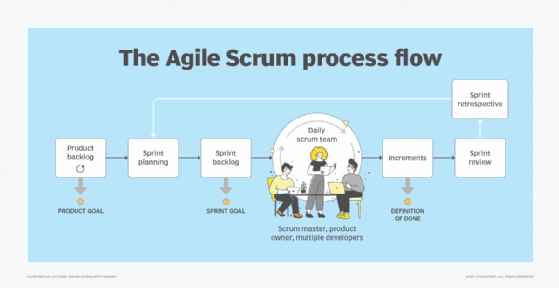
Getty Images
Know these top 5 Scrum antipatterns
Embrace sprints, set clear goals, engage with customers -- these behaviors and others will help your teams avoid common Scrum antipatterns.
Scrum is a lightweight framework designed to help teams generate value. At only 13 pages long, the Scrum Guide provides a simple starting point to help teams deliver products and seek feedback, building upon a minimal set of rules and mechanics.
However, this simplicity can be a double-edged sword. For every success pattern that Scrum offers, there are potential antipatterns -- common mistakes or dysfunctions that can be destructive, either due to misunderstandings of Scrum or the introduction of practices that undermine Scrum's core principles.
Here, we'll review five common Scrum antipatterns to help identify when you've drifted into the danger zone.
1. Break a project into sprints
Sprints are the heartbeat of Scrum, where ideas are turned into value. Each timebox of a month or less is meant to provide focus, enabling teams to commit to deliver at least one product increment that can be inspected alongside customers.
Traditional projects work through a mostly fixed list of tasks, with the aim to deliver a product after a long development cycle.
A common antipattern is to split this fixed project into sprints that don't individually deliver a releasable product increment. Instead, sprints become little more than management reporting cycles and meeting overhead.
How to avoid this Scrum antipattern. Rather than divide a large plan into smaller chunks, let the product emerge through continuous inspection and adaptation. A well-ordered backlog of valuable outcomes, not tasks, should be constantly adjusted based on lessons learned as teams deliver a new product increment each sprint.
2. Teams don't engage customers
For sprints and product increments to provide real value, teams must seek genuine feedback from customers. In Scrum, the sprint review offers a minimum opportunity to inspect the product with customers and stakeholders. Teams demonstrate the product increment, discuss the sprint goal and seek input for the next sprint plan.
The antipattern here is to exclude customers from these discussions. Only actual users can confirm whether what is built meets their needs. While other stakeholders, such as businesspeople and executives, can help generate feedback, real customers are essential.
How to avoid this Scrum antipattern. Get customer feedback. Note that the sprint review is the minimum opportunity to engage customers -- do it more often if possible.
3. Fail to set goals
Scrum tells us we should have two goals at all times:
- A medium-to-long-term product goal that describes the future state of the product toward which the team can plan.
- A short-term sprint goal, which is the single objective for the sprint.
Many teams fail by either not setting goals at all, or by setting multiple goals which dilutes focus.
Without clear, singular goals, teams often get stuck juggling unrelated tasks and struggle to deliver valuable increments. Without goals, it's hard to see the value in customer interaction -- they care about outcomes, not tasks. As a result, teams end up breaking fixed projects into sprints.
How to avoid this Scrum antipattern. Set clear goals, which can also help teams avoid other antipatterns.

4. Misuse story points to measure progress
Story points were originally designed to help teams plan their capacity without the guesswork of predicting how long tasks would take. The industry has begun to move away from story points as they often cause more harm than good. Still, they might hold value to help teams build a shared understanding of work item complexity.
The antipattern here arises when teams treat story points as a metric of value, aiming to hit a certain number or accurately guess how many points they'll deliver. Unfortunately, these arbitrary numbers have no relationship to real value.
This antipattern often emerges from previous issues: Without goals or customer feedback, how can we measure progress? Many teams fall into a trap where they count story points and report how many they delivered. This incentivizes them to deliver more stuff -- regardless of whether or how it meets customer needs.
How to avoid this Scrum antipattern. Focus on outcomes. Regularly inspect valuable product increments that achieve sprint goals.
5. Teams that are not cross-functional
The final antipattern often starts with how Scrum teams are structured. Scrum teams should be cross-functional, with all the skills needed to deliver an increment of value and achieve the sprint goal.
This doesn't mean everyone does everything, only that the team shouldn't rely on external people to achieve its goals. If existing functional silos such as dev and test are merely renamed as Scrum teams, this creates dependencies that make it nearly impossible to deliver real increments. This complicates efforts to set real goals and deliver real increments and often causes a team to fall back to focus on delivering points.
The same applies to existing team structures such as back-end and front-end teams. Even value stream-aligned teams struggle if they are not truly cross-functional.
In all cases, it becomes harder to define, build and deliver valuable products when some important skill or domain knowledge is absent from the team.
How to avoid this Scrum antipattern. To set Scrum teams up for success, rethink how teams are organized and be open to a significant change in how everyone works.
All these are antipatterns precisely because they are common. Don't feel bad if these all sound very familiar. Agility is about learning by doing, and this includes learning from mistakes. Knowing these common pitfalls can help you better avoid or remedy them and find success on your continuous improvement journey.
Michael Lloyd is an Agile leader who helps teams and organizations to implement and improve their Agile practices using Scrum, SAFe, Nexus and Kanban. He is an experienced agility coach, teaching and certifying Scrum and SAFe learners.










